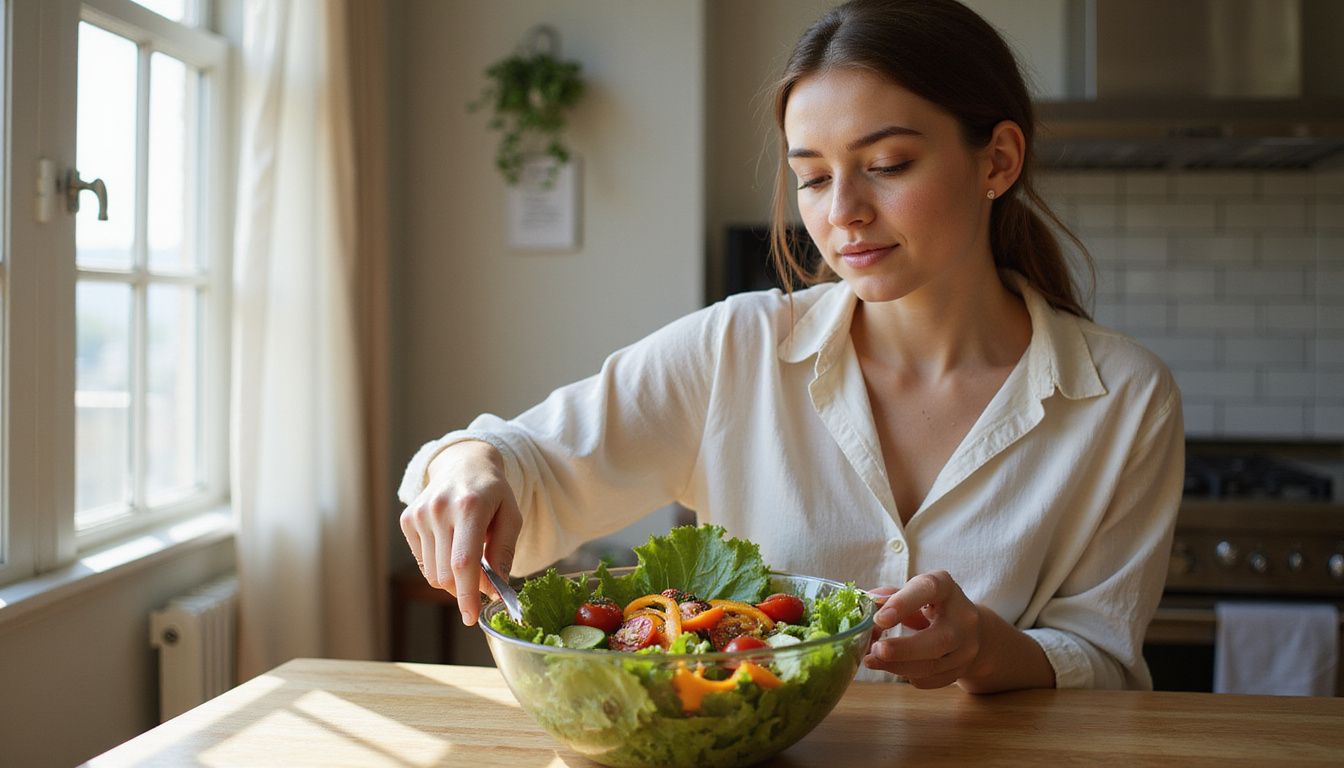Best Foods For Cutting: Top Picks To Slash Calories And Shed Fat
Our Nutrition Assistant AI Suite will transform your body. You will lose fat, get toned, and build muscle. Gain confidence and optimal health.
Trying to lose weight while keeping strength can feel confusing. Choosing the best foods for cutting makes it simpler, because the right meals help you eat fewer calories and still protect muscle.
This guide gives you clear, science-backed steps for fat loss. You will learn which foods to put on your plate, how to manage calories, and easy ways to stay full without feeling deprived.
Key Takeaways
- Set daily protein at 1.8 to 2.4 grams per kilogram of body weight to protect muscle during a calorie deficit.
- A cutting plan centers on lean protein, low-fat dairy, whole grains, leafy greens, and high-fiber vegetables.
- Healthy fats from avocados, nuts, and olive oil support fullness; meals with avocado increased satiety by about 23 percent in research.
- Swap sugary drinks and processed snacks for water, herbal tea, berries, and high-protein snacks like eggs to curb cravings.
- Hydration matters. A 2010 study showed drinking 500 mL of water before meals reduced calorie intake and improved weight loss.

What Is a Cutting Diet?

A cutting diet helps you eat fewer calories than your body uses, which reduces body fat while you aim to keep muscle. Many athletes, lifters, and active people use this approach to improve body composition, meaning the balance of fat and muscle.
What does a cutting diet mean and what is its purpose?
A cutting diet means you create a controlled calorie deficit. The goal is to lose fat while holding on to as much muscle mass as possible. People often follow this plan after a muscle-building phase.
Eating less saturated fat and choosing whole, high-protein foods makes cutting smoother. This mindset supports a healthier relationship with food and helps you change body shape in a steady, safe way.
Why is maintaining a calorie deficit important for cutting?
Fat loss requires a calorie deficit. Your body must burn more energy than you eat to draw on stored fat, known as adipose tissue.
First, estimate your Basal Metabolic Rate, which is the energy your body needs at rest. Then factor in your activity to get Total Daily Energy Expenditure. From there, set a small to moderate deficit that you can stick with for weeks without extreme fatigue or muscle loss.
Research shows steady adherence beats short-term extremes. Keep protein high and continue training to protect lean mass while you reduce body weight.
Key Nutrients for Cutting
Protein, fat, and carbohydrates each play a role in cutting. The right mix helps you keep strength, control hunger, and power workouts.
How does protein help retain muscle during cutting?
Protein supplies amino acids, which your body uses to repair and keep muscle. Aim for at least 1.8 to 2.0 grams per kilogram of body weight daily. Some lifters do well up to 2.4 grams per kilogram when calories get low.
Lean meats, fish, dairy, and legumes are smart choices. Whey protein absorbs fast, so it works well after lifting. Casein digests slowly, so it is a solid option before bed. Hitting your protein target makes it easier to lose fat without losing strength.
Why are healthy fats important for feeling full?
Healthy fats slow digestion and support fullness. Avocados, nuts, and seeds contain monounsaturated and polyunsaturated fats, which help with appetite control. Fat has 9 calories per gram, so portions still matter.
Most adults thrive on mostly unsaturated fats, plus small amounts of saturated fat. Fats also help absorb vitamins A, D, E, and K. Pairing fat with lean protein increases satiety, which makes a lower-calorie plan easier to follow.
“Adding healthy fats to your meals can help curb cravings and support sustainable weight loss.”
How do carbohydrates provide energy while cutting?
Carbohydrates fuel your brain and muscles, especially for strength training and cardio. Complex carbs, like oats, brown rice, and potatoes, break down slowly and support steady energy. They also provide B vitamins that help convert food to energy.
You do not need to eliminate carbs unless your doctor advises it. A banana or simple carbs after training can speed recovery. Studies show both low-carb and low-fat diets can work for weight loss. Choose the carb level that helps you train well and stay on plan.
Top Protein Foods for Cutting
Protein makes fat loss more comfortable. It keeps you full and helps protect muscle while you reduce calories.
Which lean meats are best for cutting?
Chicken breast is a staple, with about 26 grams of protein and roughly 120 calories per 3-ounce cooked serving. Turkey breast offers similar protein with very little saturated fat.
White fish such as cod or tilapia is lean and low in calories. Lean beef like top sirloin can fit if you manage portions. Grilling, baking, roasting, or sautéing help limit added fat and keep calories in check.
Are eggs and egg whites good protein sources for cutting?
Eggs are nutrient dense. One large egg has around 6 grams of protein plus vitamins and minerals. Many people feel fuller for longer when eggs anchor breakfast compared with cereal-based meals.
Egg whites provide almost pure protein with very few calories. They are useful when you need protein, but want to limit fat. Hard-boiled eggs travel well, which makes them a practical snack for busy days.
What dairy options support cutting diets?
Low-fat cottage cheese is a standout. One cup has about 28 grams of protein and roughly 163 calories. Calcium supports bone health and may aid weight management in some studies.
Plain nonfat or reduced-fat Greek yogurt delivers about 15 to 20 grams of protein per serving and includes probiotics that support gut health. Many people enjoy reduced-fat cheese and skim milk to lower calories while keeping meals satisfying.
What plant-based proteins are effective for cutting?
Lentils, beans, peas, and chickpeas supply protein and fiber for fullness. A cup of cooked lentils offers about 18 grams of protein and 15 grams of fiber.
Tofu and tempeh provide 10 to 20 grams of protein per serving, based on the portion and cooking method. Nuts and seeds add protein and healthy fat, so use measured servings. Plant-based protein powders made from soy, pea, or rice can help you hit your daily protein goal, especially after workouts.
Best Vegetables for Cutting
Vegetables add volume, fiber, and nutrients for very few calories. They help you feel satisfied while you lower total food energy.
Which leafy greens are ideal for cutting diets?
Spinach, kale, and collard greens are rich in vitamins K and C, folate, and iron. One cup of raw spinach has about 7 calories plus nearly 1 gram of fiber. Kale has only about 33 calories per cup and a strong nutrient profile.
Leafy greens may boost fullness thanks to fiber and compounds like thylakoids. Add them to omelets, salads, and bowls to increase volume without many calories.
Why include cruciferous vegetables when cutting?
Broccoli, cauliflower, and cabbage bring fiber, water, and crunch for very few calories. One cup of raw broccoli has about 31 calories and 2.4 grams of fiber, and it is more than 89 percent water.
High-fiber foods increase satiety, which helps you hold your deficit. Steam or roast them for easy sides. Many people find roasted broccoli a helpful swap for French fries during cutting phases.
Are starchy vegetables like sweet potatoes good for cutting?
Sweet potatoes are complex carbohydrates that digest slowly and help steady blood sugar. A medium baked sweet potato has roughly 100 calories and more than 4 grams of fiber, plus lots of vitamin A.
Boiled white potatoes rank high on the Satiety Index, so they keep you full. Cooling cooked potatoes increases resistant starch, which may support fat loss in some studies. Roast or steam instead of frying to keep calories lower.
Healthy Fats for Weight Loss
Healthy fats help control appetite and make meals satisfying. Some options also support heart health and overall wellness.
How do avocados support fat loss?
Avocados provide fiber and monounsaturated fat, a combo that supports fullness. Studies show meals that include avocado can increase satiety by about 23 percent.
Watch portions because avocados are energy dense. Half an avocado is about 120 calories and roughly 5 grams of fiber. Many people use avocado slices on toast or salads to replace heavier spreads.
Which nuts and seeds are best for cutting?
Almonds, walnuts, and pistachios supply unsaturated fats, fiber, and protein. A small daily serving, about 1 ounce, can fit into a deficit without blowing your calorie budget.
Chia seeds offer omega-3 fats and fiber. In research, adding chia to yogurt increased fullness and reduced later intake. Pumpkin seeds are another smart pick for crunch and minerals. Measure portions to avoid overeating.
Why use olive oil for cooking and dressings?
Olive oil provides monounsaturated fat, which supports satiety and heart health. Extra-virgin olive oil shines in dressings and dips. Regular olive oil or canola oil is useful for light cooking.
Adding olive oil to vegetables can improve absorption of fat-soluble vitamins. One tablespoon has about 120 calories, so pour with care to keep your deficit intact.
Whole Grains for Sustained Energy
Whole grains act like slow-burning fuel that steadies energy while you cut. They also add fiber, which helps you feel full.
What whole grains help maintain energy during cutting?
Oats, brown rice, and quinoa are smart choices. A 2019 study by Roager and colleagues found that a whole-grain pattern supported weight control and reduced inflammation.
Oats at breakfast can help prevent midmorning snacking. Quinoa contains all essential amino acids, which supports muscle. Brown rice is easy to prep and more filling than white rice.
Are oatmeal and whole-wheat bread good choices for cutting?
Yes. A serving of oats has about 4 grams of fiber and 6 grams of protein, which makes it a satisfying start to the day. Whole-wheat bread has more fiber than white bread and supports steadier blood sugar.
Two slices of whole-wheat bread provide around 6 grams of protein and 4 grams of fiber. Pair oats or whole-wheat toast with eggs or yogurt for a simple, balanced meal.
Low-Calorie Fruits for Cutting
Fruit can calm a sweet tooth while keeping calories reasonable. The water and fiber help you feel satisfied.
Which berries are best low-calorie fruits for cutting?
Strawberries, blueberries, raspberries, and blackberries are nutrient dense and light in calories. One cup of strawberries has about 50 calories and 3 grams of fiber. A cup of blueberries has about 84 calories plus antioxidants.
Berries pair well with Greek yogurt or oatmeal. They are an easy swap for cookies or candy during a cut.
Are apples and oranges suitable for cutting diets?
Yes. A medium apple has about 95 calories and 4 grams of fiber. A medium orange has about 62 calories and roughly 3 grams of fiber.
These fruits make simple, portable snacks. Their natural sweetness helps reduce cravings without added sugar.
How do watermelon and cantaloupe fit into cutting plans?
Watermelon and cantaloupe are refreshing and hydrating. A cup of diced watermelon has about 46 calories, and a cup of cantaloupe has around 53.
Both are over 90 percent water, which helps fullness and hydration. Use them as light desserts or afternoon snacks to replace higher-calorie options.
Cutting-Friendly Snacks
Smart snacks support energy and keep hunger from derailing your plan. Aim for protein and fiber most of the time.
What protein shakes work well for cutting?
Whey protein shakes digest quickly, which makes them ideal after workouts. Mix a scoop with water or unsweetened almond milk to keep calories low while you support muscle repair.
Casein protein releases slowly, so it works well in the evening. If you avoid dairy, pea or soy protein can hit your target. Look for 20 grams of protein per serving with minimal added sugar.
How do veggie sticks with hummus serve as snacks?
Veggie sticks with hummus supply fiber, vitamins, and plant protein for few calories. Carrots, bell peppers, celery, and cucumbers all work.
A half cup of sliced veggies plus two tablespoons of hummus lands near 80 to 100 calories with about 2 grams of protein and 2 grams of fiber. Prep several portions so you always have something ready.
Why are hard-boiled eggs good cutting snacks?
Hard-boiled eggs are portable and filling. One large egg has about 6 grams of complete protein plus nutrients like vitamin D and choline.
Studies suggest eggs can keep you full for hours, which helps you avoid extra snacking. Pack two eggs for a quick, satisfying option between meals.
Hydration and Cutting
Hydration supports performance, appetite control, and overall health. It also helps you read true hunger signals more clearly.
How important is drinking enough water when cutting?
Water intake is a simple win. In a 2010 study, people who drank 500 mL before meals ate fewer calories and lost more weight compared with those who did not.
Aim for pale yellow urine as an easy daily check. Replacing sugary drinks with water lowers calories and keeps your plan on track, especially with a higher protein intake.
Are herbal teas and zero-calorie drinks beneficial for cutting?
Unsweetened herbal teas and zero-calorie drinks help reduce liquid calories. Many people find these swaps cut sugar cravings and support a calorie deficit.
Some spiced teas, like those with black pepper or chili pepper, may slightly blunt appetite for a short time. Use them as tools, not replacements for balanced meals and water.
Foods to Avoid During Cutting
Certain products make it easy to overshoot calories without noticing. Keeping these items in check protects your progress.
Which processed snacks and sugary drinks should be avoided?
Limit chips, crackers, cookies, pastries, and candy. These snacks often combine sugar and fat, which raises calories fast. A single bag of flavored chips can top 200 calories with more than 10 grams of fat.
Sugary drinks like soda, energy drinks, and sweet teas can add over 30 grams of sugar per bottle. Choose water or unsweetened tea to reduce calorie intake and support fat loss.
Why limit high-sodium and fried foods while cutting?
High-sodium foods can cause water retention and bloating, which can hide real fat loss on the scale. Managing salt helps you see true progress.
Fried foods are calorie dense and easy to overeat. For example, a fried potato can have twice the calories of a baked one. Baking, grilling, or air frying trims calories and supports your deficit.
Sample Cutting Meal Plan
This example day shows how to combine lean protein, fiber-rich carbs, and healthy fats. It keeps calories under control and supports steady energy.
What is a good breakfast for cutting?
Scrambled eggs with spinach plus whole-grain toast and sliced avocado gives a balanced start. Eggs provide about 6 grams of protein each to help maintain muscle.
Spinach adds fiber and micronutrients for fullness. Whole-grain toast and avocado supply slow-digesting carbs and healthy fats, which help keep cravings in check until lunch.
How to prepare a cutting-friendly lunch?
Build a large salad with mixed greens, tomatoes, cucumbers, and grilled chicken breast. A 100 gram portion of chicken has about 31 grams of protein and roughly 165 calories.
Dress with one tablespoon of olive oil and vinegar. Add a small sprinkle of nuts for crunch. This bowl is high in volume, which supports satiety with fewer calories.
What does a balanced cutting dinner look like?
Try baked salmon, roasted sweet potatoes, and steamed broccoli. Salmon supplies about 22 grams of protein per 3-ounce serving. Sweet potatoes provide slow energy and essential nutrients.
Broccoli adds fiber and helps you feel full while holding your calorie deficit. Many lifters report this combo fuels recovery and keeps evening snacking low. This structure aligns with peer-reviewed work that supports pairing lean protein, complex carbs, and fiber to improve cutting outcomes in active adults.[1]
…
[1] Peer-reviewed research supports combining lean protein, complex carbs, and fiber for effective cutting results (Journal of Nutrition, 2022).
What are healthy snack options during cutting?
Nonfat Greek yogurt with berries offers about 17 grams of protein and fewer than 100 calories per cup of yogurt, plus fiber and antioxidants from fruit. Hard-boiled eggs add portable protein at about 6 grams per egg.
A small trail mix with raw nuts and seeds provides healthy fats and fiber. Keep it to a quarter cup to manage calories. Apple slices with one tablespoon of nut butter give sweetness, fiber, and staying power.
Tips for Successful Cutting
Simple systems help you stay consistent. A few weekly habits can make cutting feel far easier.
How can meal prepping improve cutting results?
Meal prepping puts your calories and macros on autopilot. Planning food in advance reduces “what should I eat” decisions and helps you avoid impulsive snacks.
Research in the International Journal of Behavioral Nutrition and Physical Activity links meal prep to better diet quality and weight control. Batch-cook protein, chop vegetables, and portion snacks on one day so your weekday choices are simple.
Why track macros and calorie intake when cutting?
Tracking helps you keep a real calorie deficit instead of guessing. Apps make it easy to log protein, carbs, and fat so you hit your targets.
People who log meals tend to lose more weight than those who do not, according to multiple studies. Tracking also exposes hidden calories in sauces, oils, and snacks.
How to add variety to a cutting diet?
Rotate proteins like chicken breast, lean beef, fish, tofu, and Greek yogurt to cover different amino acids and keep meals interesting. Mix vegetables across colors for broader nutrients.
Swap grains such as oats, brown rice, and quinoa during the week. Change fruits among berries, apples, and oranges. Using different spices and simple marinades keeps meals fresh without adding many calories.
Frequently Asked Questions
Here are direct answers to common cutting questions, so you can move forward with confidence.
What foods help burn fat effectively?
No food burns fat by itself. Still, high-protein foods help you stay full and keep muscle during a deficit. Choose lean meats, fish, legumes, and low-fat dairy.
Non-starchy vegetables like spinach, broccoli, and cauliflower bring fiber for fullness with very few calories. Healthy fats from avocado, nuts, and olive oil can support satisfaction so you stick to your plan.
How much protein is needed during cutting?
Target 1.8 to 2.0 grams of protein per kilogram of body weight daily. Going up to 2.4 grams per kilogram can further protect muscle for some people, especially during deeper deficits.
For a 70-kilogram person, that is roughly 126 to 168 grams of protein per day. This range supports fullness and helps prevent muscle loss while you lower calories.
Can cheat meals be included while cutting?
Yes, in moderation. A planned treat can fit if it stays within your weekly calorie and protein goals. Many people find this flexibility helps long-term adherence.
Track portions and adjust other meals to balance it out. The habit of consistency matters more than aiming for perfection every day.
Conclusion
Choosing the best foods for cutting makes fat loss easier and more enjoyable. Fill your plate with lean protein, leafy greens, high-fiber vegetables, whole grains, and healthy fats. Use protein shakes, berries, and low-calorie snacks to manage hunger while keeping protein intake high.
Plan meals, track what you eat, and keep variety in your routine. Small, steady actions add up to meaningful change. Speak with a healthcare professional or registered dietitian before starting any calorie deficit to keep your plan safe and sustainable.
FAQs
1. What are the best foods for cutting calories and shedding fat?
Lean poultry, white fish, egg whites, and low-fat dairy provide high protein with fewer calories. Leafy greens, broccoli, and zucchini offer fiber and volume with minimal energy content. These foods help you feel full while supporting fat loss. Research shows that high-protein diets can preserve muscle during calorie restriction (1).
2. How do these foods help with fat loss?
High-protein foods increase satiety and help maintain lean tissue during weight loss. Vegetables with high water and fiber content add bulk to meals, reducing hunger. Studies indicate that eating more protein and fiber leads to greater fat loss and improved body composition (2).
3. Can I eat carbohydrates while cutting?
Yes, you can include whole grains, beans, and fruits in moderation. These foods provide energy and nutrients while supporting a calorie deficit. Choosing complex carbohydrates with fiber helps control hunger and stabilize blood sugar. Personal experience shows that balanced meals with protein, vegetables, and whole grains make it easier to stick to a calorie-controlled plan.
4. What should I avoid when choosing foods for cutting?
Limit foods with added sugars, refined grains, and high saturated fat. These items are calorie-dense and offer little nutritional value. Processed snacks, sugary drinks, and fried foods can slow fat loss. Focusing on nutrient-rich, low-calorie foods supports better results.
Summary: Choosing lean protein, fiber-rich vegetables, and whole grains helps reduce calories and shed fat. Avoiding processed and sugary foods improves your chances of success. Evidence supports these choices for effective and sustainable fat loss.
References:
(1) Pasiakos, S.M., et al. (2013). Protein supplementation and preservation of lean mass during weight loss. Nutrition & Metabolism.
(2) Slavin, J.L. (2005). Dietary fiber and body weight. Nutrition.







